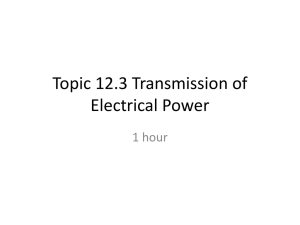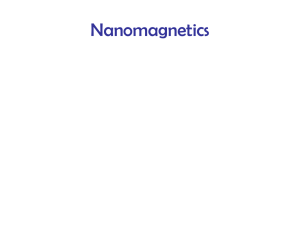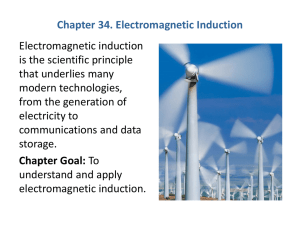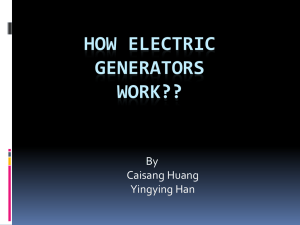Superconductor Dynamics
advertisement
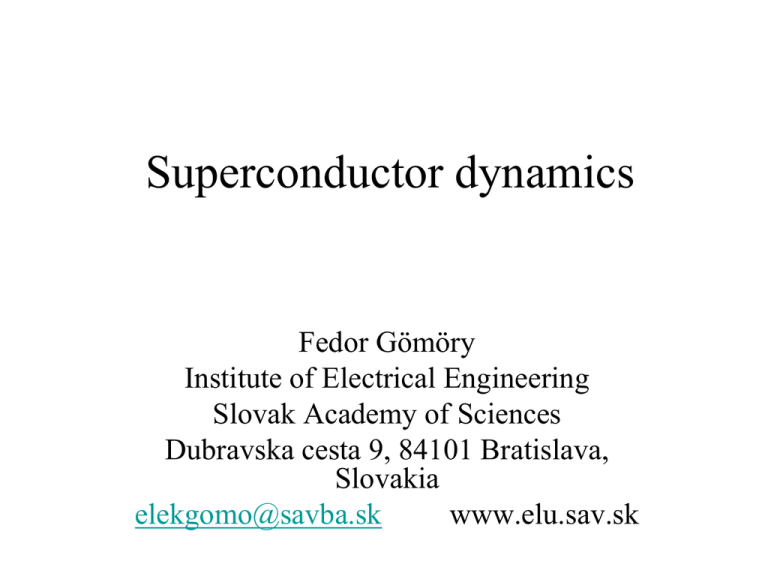
Superconductor dynamics Fedor Gömöry Institute of Electrical Engineering Slovak Academy of Sciences Dubravska cesta 9, 84101 Bratislava, Slovakia elekgomo@savba.sk www.elu.sav.sk m Some useful formulas: magnetic moment of a current loop m IS [Am2] I S m magnetization of a sample M [A/m] V m alternative (preferred in [T] M 0 V SC community) Measurable quantities: magnetic field B [T] – Hall probe, NMR average of magnetic field voltage from a pick-up coil [V] dΨ dΦ dB ui N NS dt dt dt linked magnetic flux number of turns Y area of single turn ui Outline: 1. Hard superconductor in varying magnetic field 2. Magnetization currents: 3. Possibilities for reduction of magnetization currents 4. Methods to measure magnetization and AC loss Flux pinning Coupling currents Outline: 1. Hard superconductor in varying magnetic field 2. Magnetization currents: 3. Possibilities for reduction of magnetization currents 4. Methods to measure magnetization and AC loss Flux pinning Coupling currents Superconductors used in magnets - what is essential? type II. superconductor (critical field) high transport current density Superconductors used in magnets - what is essential? type II. superconductor (critical field) mechanism(s) hindering the change of magnetic field distribution => pinning of magnetic flux = hard superconductor 0 0 0 0 0 0 0 FL j B gradient in the flux density Bz 0 j y x pinning of flux quanta distribution persists in static regime (DC field), but would require a work to be changed => dissipation in dynamic regime (repulsive) interaction of flux quanta => flux line lattice summation of microscopic pinning forces + elasticity of the flux line lattice = macroscopic pinning force density Fp [N/m3] 0 2 1015 Vs 0 B 2 a 0 a B B 1T; macroscopic behavior described by the critical state model [Bean 1964]: a 45 nm local density of electrical current in hard superconductor is either 0 in the places that have not experienced any electric field or the critical current density, jc , elsewhere in the simplest version (first approximation) jc =const. Outline: 1. Hard superconductor in varying magnetic field 2. Magnetization currents: 3. Possibilities for reduction of magnetization currents 4. Methods to measure magnetization and AC loss Flux pinning Coupling currents Transport of electrical current I e.g. the critical current measurement 0A 20 A 80 A 20 A 100 A 0A Transport of electrical current I e.g. the critical current measurement 0A 20 A 100 A j =+ jc j =0 80 A 20 A 0A Transport of electrical current I e.g. the critical current measurement 0A 20 A 100 A j =+ jc j =0 80 A 20 A 0A Transport of electrical current I e.g. the critical current measurement 0A 20 A 100 A j =+ jc j =0 80 A 20 A j =- jc 0A Transport of electrical current I e.g. the critical current measurement 0A 20 A 100 A j =+ jc j =0 80 A 20 A j =- jc 0A Transport of electrical current I e.g. the critical current measurement 0A 20 A 100 A j =+ jc j =0 80 A 20 A 0A j =- jc persistent magnetization current Transport of electrical current AC cycle with Ia less than Ic : neutral zone persistent magnetization current 80 60 -80 -60 0 A AC transport in hard superconductor is not dissipation-less (AC loss) Q IUdt Id T neutral zone: j =0, E = 0 U check for hysteresis in I vs. plot Φ U t AC transport loss in hard superconductor 1.5E-05 1.0E-05 [Vs/m] 5.0E-06 -150 0.0E+00 -100 -50 0 50 -5.0E-06 -1.0E-05 -1.5E-05 I [A] hysteresis dissipation AC loss 100 150 Hard superconductor in changing magnetic field 0 0 30 50 -50 -40 40 mT 0 50 mT Hard superconductor in changing magnetic field 0 0 30 50 -50 -40 40 mT 0 50 mT Hard superconductor in changing magnetic field 0 0 30 50 -50 -40 40 mT 0 50 mT Hard superconductor in changing magnetic field 0 0 30 50 -50 -40 40 mT 0 50 mT Hard superconductor in changing magnetic field 0 0 30 50 -50 -40 40 mT 0 50 mT Hard superconductor in changing magnetic field 0 0 30 50 -50 -40 40 mT 0 50 mT Hard superconductor in changing magnetic field 0 0 30 50 -50 -40 40 mT 0 50 mT Hard superconductor in changing magnetic field dissipation because of flux pinning Ba y x volume loss density Q magnetization: (2D geometry) [J/m3] Q Ba dM V 1 M x. j ( x, y)dxdy SS Round wire from hard superconductor in changing magnetic field 3.E+04 Ms 2.E+04 M [A/m] 1.E+04 Bp 0.E+00 -1.E+04 -2.E+04 -3.E+04 -0.06 -0.04 -0.02 0 0.02 0.04 0.06 B [T] Ms saturation magnetization, Bp penetration field Round wire from hard superconductor in changing magnetic field estimation of AC loss at Ba >> Bp 3.E+04 2.E+04 M [A/m] 1.E+04 0.E+00 -1.E+04 -2.E+04 -3.E+04 -0.25 -0.2 -0.15 -0.1 -0.05 0 0.05 0.1 0.15 B [T] Q 4 Ba M s V 0.2 0.25 (infinite) slab in parallel magnetic field – analytical solution B penetration field w B p 0 jc 2 w Bp M s jc 4 20 w j 3 2 Ba Q 1 3 Bp V 0 4 2 2 B p Ba B p 3 Q 4Ba M s for Ba<Bp for Ba>Bp Slab in parallel magnetic field – analytical solution 1.E+05 Q 4Ba M s 1.E+04 1.E+03 1.E+02 1.E+01 3 Q/V [J/m] 1.E+00 1.E-01 jc=10^8 A/m2, w=1 mm (Bp = 63 mT) 1.E-02 1.E-03 jc=10^8 A/m2, w=0.1 mm (Bp = 6.3 mT) 1.E-04 1.E-05 jc=10^7 A/m2, w=1 mm (Bp = 6.3 mT) 1.E-06 jc=10^7 A/m2, w=0.1 mm (Bp = 0.63 mT) 1.E-07 1.E-08 1.E-05 1.E-04 1.E-03 Ba [T] 1.E-02 1.E-01 1.E+00 Outline: 1. Hard superconductor in varying magnetic field 2. Magnetization currents: 3. Possibilities for reduction of magnetization currents 4. Methods to measure magnetization and AC loss Flux pinning Coupling currents Two parallel superconducting wires in metallic matrix Ba coupling currents in the case of a perfect coupling: 0 20 80 60 mT Magnetization of two parallel wires 2.E+05 1.E+05 M [A/m] 5.E+04 uncoupled: 0.E+00 -5.E+04 -1.E+05 coupled: -2.E+05 -0.15 -0.1 -0.05 0 B [T] 0.05 0.1 0.15 Magnetization of two parallel wires 2.E+05 1.E+05 M [A/m] 5.E+04 uncoupled: 0.E+00 -5.E+04 -1.E+05 coupled: -2.E+05 -0.15 -0.1 -0.05 0 0.05 0.1 B [T] how to reduce the coupling currents ? 0.15 Composite wires – twisted filaments lp B 1 good interfaces t m 1 1 t m bad interfaces 1 S SC Sm B j j l p B 2t Composite wires – twisted filaments coupling currents (partially) screen the applied field Bext Bi Bi Bext B t - time constant of the magnetic flux diffusion 0 2 t lp 2 2 A.Campbell (1982) Cryogenics 22 3 K. Kwasnitza, S. Clerc (1994) Physica C 233 423 K. Kwasnitza, S. Clerc, R. Flukiger, Y. Huang (1999) Cryogenics 39 829 shape factor (~ aspect ratio) in AC excitation Q B 2 2 2 V 0 1 2 max round wire 0 Q B 2 2 V 0 1 2 max Outline: 1. Hard superconductor in varying magnetic field 2. Magnetization currents: 3. Possibilities for reduction of magnetization currents 4. Methods to measure magnetization and AC loss Flux pinning Coupling currents Persistent currents: at large fields proportional to Bp ~ jc w width of superconductor (perpendicular to the applied magnetic field) = magnetization reduction by either lower jc or reduced w lowering of jc would mean more superconducting material required to transport the same current thus only plausible way is the reduction of w effect of the field orientation perpendicular field 2.E+05 1.E+05 parallel field M [A/m] 5.E+04 0.E+00 -5.E+04 -1.E+05 -2.E+05 -0.15 -0.1 -0.05 0 B [T] Q 4 Ba M s V 0.05 0.1 0.15 Magnetization loss in strip with aspect ratio 1:1000 1.E+07 1.E+06 Q 4 Ba M s V H B 1.E+05 1.E+04 1.E+03 H B 3 Q/V [J/m ] 1.E+02 1.E+01 1.E+00 1.E-01 1.E-02 parallel 1.E-03 1.E-04 perpendicular 1.E-05 1.E-06 1.E-07 1.E+00 1.E+01 1.E+02 1.E+03 1.E+04 HBmax [A/m] a/0 [A/m] 1.E+05 1.E+06 in the case of flat wire or cable the orientation is not a free parameter = reduction of the width e.g. striation of CC tapes B B ~ 6 times lower magnetization striation of CC tapes but in operation the filaments are connected at magnet terminations B B coupling currents will appear => transposition necessary Coupling currents: at low frequencies proportional to the time constant of magnetic flux diffusion 0 l p 2 t 2 2 transposition length effective transverse resistivity = filaments (in single tape) or strands (in a cable) should be transposed = low loss requires high inter-filament or inter-strand resistivity but good stability needs the opposite Outline: 1. Hard superconductor in varying magnetic field 2. Magnetization currents: 3. Possibilities for reduction of magnetization currents 4. Methods to measure magnetization and AC loss Flux pinning Coupling currents Different methods necessary to investigate • Wire (strand, tape) • Cable • Magnet shape of the excitation field (current) pulse transition unipolar harmonic relevant information can be achieved in harmonic regime final testing necessary in actual regime ideal magnetization loss measurement: pick-up coil wrapped around the sample Bext induced voltage um(t) in one turn: um Area S dm (t ) dB (t ) um (t ) S dt dt 1 B (t ) Bint (t )dS Bext (t ) 0 M (t ) SS dM (t ) dBext (t ) um (t ) S 0 dt dt pick-up coil voltage processed by integration either numerical or by an electronic integrator: 1 0 M (t ) um (t )dt Bext (t ) S Method 1: double pick-up coil system with an electronic integrator : measuring coil, compensating coil Bext 1 0 M (t ) u M (t )dt S um uM uc 1 int Udt M = M = /2 AC loss in one magnetization cycle [J/m3]: T Q BdM B(t ) 0 dM dt dt B = 3/2 =0 Harmonic AC excitation – use of complex susceptibilities Bext (t ) Ba cost 0 M (t ) Ba n ' cosnt n " sin nt n 1 Temperature dependence: fundamental component n =1 AC loss per cycle Wq " ” Ba2 T 0 energy of magnetic shielding Ba2 Wm ' 2 0 ’ -1 Method 2: Lock-in amplifier – phase sensitive analysis of voltage signal spectrum in-phase and out-of-phase signals U nS U nC 1 2 uM (t ) sin ntdt 0 1 2 uM (t ) cos ntdt Bext Ba cost reference signal necessary to set the frequency phase taken from the current energizing the AC field coil 0 Bext reference um uM UnS Lock-in amplifier uc UnC Method 2: Lock-in amplifier – only at harmonic AC excitation Bext Ba cost uM (t ) SBa sin t n n ' sin nt n " cosnt n1 empty coil fundamental susceptibility U1S U1S ' 1 1 SBa UN U1C U1C " SBa UN sample magnetization higher harmonic susceptibilities U nS n ' nU N U nC n" nU N Real magnetization loss measurement: Pick-up coil Calibration necessary M C udt sample by means of: measurement on a sample with known properrties calibration coil numerical calculation … AC loss can be determined from the balance of energy flows AC power supply AC power flow AC loss in SC object Solution 1- detection of power flow to the sample AC power supply AC power flow AC loss in SC object Solution 2- elimination of parasitic power flows AC power supply AC power flow AC loss in SC object Loss measurement from the side of AC power supply: LOCK-IN Rogowski coil LN2 channel A channel B generator transformer Im AMPLIFIER power supply Psample I mU B sample Loss measurement from the side of AC power supply: YI hysteresis loop registration for superconducting magnet (Wilson 1969) SC magnet Udt Y RI I y x Conclusions: 1) Hard superconductors in dynamic regime produce heat because of magnetic flux pinning -> transient loss, AC loss 2) Extent of dissipation is proportional to macroscopic magnetic moments of currents induced because of the magnetic field change 3) Hysteresis loss (current loop entirely within the superconductor) reduced by the reduction of superconductor dimension (width) 4) Coupling loss (currents connecting parallel superconductors) reduced by the transposition (twisting) and the control of transverse resistance 5) Minimization of loss often in conflict with other requirements 6) Basic principles are known, particular cases require clever approach and innovative solutions
